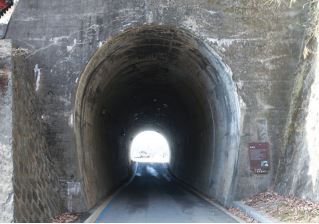Baramssoeneun-gil’(바람쐬는 길)
What is in a name? A name can be used to represent history, hope, and positive characteristics. This year, the JBNU Globe decided to pay attention to roads with unique names in Jeonju. This section is designed to showcase the hidden stories and hidden sites contained in road names. Let's go to every corner of Jeonju and see what lies hidden behind the famous tourist attractions.
First, let us introduce ‘Baramssoeneun-gil’(바람쐬는 길). The name of the trail means “road with a breeze.” Before it was developed as a trail, it had been a railway built by the Japanese Empire. To rehabilitate the ecosystem and scenery, Jeonju-si designed a recovery plan for the surrounding environment. The road spreads out near Jeonju Hanok Village. After immersing yourself in the classic atmosphere of Jeonju Hanok Village, you can refresh your spirit by taking a walk down the road.

1) Hanbyeokdang
This pavilion, built into the cliff s at the foot of Seungam Mountain, was built as a summer house in the Joseon Dynasty. Under the pavilion, clear water flows. The name ‘Hanbyeokdang’ is derived from the way the water cascades over the rocks like white jade.

2) Hanbyeok Tunnel
In the Japanese colonial era, the tunnel was laid out as part of the railway. The railway stretching from Namwon to Jeonju, was opened in October 1931. At the time, elders were opposed to the construction of a railway because it was believed that it would cut off the Earth’s spirit.
As time went on, the public opinion shifted, and the Hanbyeok tunnel became a famous spot for picnics and taking pictures. Although many students and citizens saw this area as the perfect background for photoshoots, it is also an area with a long, painful history.

3) Jeonju Nature Ecological Museum
If you walk down the trail for about five minutes, you can see a peculiar building. The Jeonju Nature Ecological Museum stands in front of the clean waves of Jeonju Stream, where otters and lovebirds live.
The appearance of the Jeonju Nature Ecological Museum is outstanding. In particular, the building was designed with natural rhythmic aesthetics in mind - seamlessly blending traditional Korean architectural design with shapes inspired by nature.
Interestingly, the front entrance forms the image of a fish’s mouth, and the rear entrance combines tradition and modernity in the shape of a fishtail.

4) Cafe of the Wind
The cafe of the wind is a small book cafe located five minutes from Hanbyeokdang by foot. At this cafe, you can enjoy traditional Korean teas, such as Raspberry, Omija and others at an affordable price less than 4,000 won each.
Inside, there are three tables and various kinds of books such as history, philosophy, and literature. If you have walked from Jeonju Hanok Village to Hanbyeokdang without a break, how about taking a moment to enjoy a cup of coff ee while feeling the wind blow?

5) Picturesque Village, Blooming Village: Wonsaek Village
Wonsaek Village is one of the twelve villages supported by Jeollabuk-do to revitalize rural communities. Entering the village, the fi rst thing that will catch your eye is the masterpiece located on one side wall.
A series of murals showcase the village’s picturesque identity. In addition, there are murals from house to house. Compared to Jaman Mural Village located near Jeonju Hanok Village, Wonsaek Village is flat, making it easier to walk around and take pictures.
Another notable characteristic is that there is a cycling track. You can take a walk along this route or ride a four-seat bicycle or electric car with friends or family. If you don’t have our own ride, bicycles can be rented in the village. This road, leading to Jeonju Hanok Village, is nestled between a scenic wooded mountain and the Jeonjucheon Stream. Thus, you can enjoy different scenery when you go and return.
Visitors can experience various programs such as making kimchi, making soy sauce, and harvesting pears. Accommodation is also available for visitors who plan to stay the night. If you are looking for a unique tourist spot in Jeonju, visit ‘Wonsaek Village’.
By Lee Won-jun(Editor-in-chief), Gu Seo-yoon(Editor)

